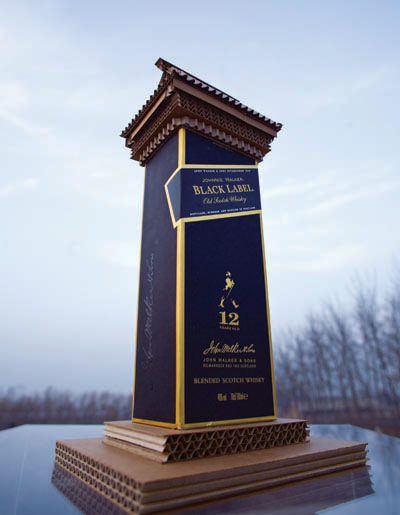GAO YANSONG: THE HIGHEST EXCELLENCE AS WATER
| April 1, 2010 | Post In LEAP 2

This is in all respects a very low-carbon show. Besides its lighting and a few red projections (not necessarily turned on) on some pieces, the exhibition does not consume any energy, and the materials used in the installations are simply paper and cardboard boxes that can be turned back to pulp and reused. Any strangeness about the show comes from its concept of “low-carbon” art based entirely on everyday discards—the materials used for the five groups of pieces probably do not add up to the leftovers of a single piece by some artists. How much can one spend on multicolored reused packaging sold by the kilo? And what’s more, the technical skills needed for the construction of Gao Yansong’s pavilions, towers and structures from piled-up boxes do not exceed the level of an elementary school student in arts and crafts class.
Gao Yansong’s works have only been in the public view since 2008, and this is his second solo outing. Yet perhaps for the above reasons his work, unskilled and essentially cost-free to produce, has largely been dismissed as outside the scope of contemporary art criticism. Existing critiques, such as they are, are mostly impenetrable, in large part because their numerous interpretations and projected symbolism serve as safeguards for actual direct visual experience and current practical taboos.
There is in fact nothing intentionally mystifying about this exhibition at the China Art Archives & Warehouse besides the title, taken from a passage in the Dao De Jing: “The highest excellence is like that of water. The excellence of water appears in its benefiting all things, and in its occupying, without striving, the low place which all men dislike. Hence it is near to the Way.” But in fact with the tiniest bit of effort anyone can understand the main point of this allusion as it relates to the artist’s work: “downstream,” an expression that in Chinese also means vulgar or lowbrow. What’s “downstream” here is Gao Yansong’s sudden (as far as the art world is concerned) and uncouth appearance on the scene. Gao maintains his original identity as an uninhibited emerging new artist in opposition to the increasingly illogical, upper-class affectations of Chinese contemporary art: the overheated middle-class worldview, frivolous petit bourgeois sentiment, hollow embrace of affluence and empty prattling metaphysics.
Water flowing downstream is natural; in people, we might regard going “downstream” as having the courage to occupy the “low place which all men dislike.”What do all men dislike? Nothing but unadorned reality, truth unconcerned with rhetoric—in other words, going downstream is being willing to play the villain when everyone else is exclaiming how great the situation is, to grin like the bad guy standing outside of the gentle, accepted ideology. Gao Yansong uses packaging that once contained cigarettes, liquor, tea, gourmet food and even sex toys and Viagra to construct structures and landscapes of all shapes and sizes. Staunch memorials of cake boxes, a cluster of liquor-container steles, a Viagra temple, a “Lord of the Rings” resplendent in brand names, marching forward with his member nobly erect, present to us a reality. This reality, despite being already consumed, stands just as dazzling and even more seductive, portraying a fragile world of luxury and decadence that swallows and spits money and corruption and yet stands precariously on the edge of collapse. Since the product packaging and the scenes it forms borrow from religious and spiritual imagery of temples and steles, these sculptures come to represent a challenge and criticism of the entire spiritual history and present condition of the Chinese nation. This does not mean that what the curators hope to express here is that our beliefs and aesthetic traditions are being objectified. To the contrary, what I saw here was the resurgence of a traditional aesthetic, epistemological and belief system in the form of a contemporary art experiment. This resurgence is not a triumphant homecoming, nor is it the return of a prodigal son—it is a vengeful return, a return to the world of the living from the depths of the underworld.
Ultimately, these fantastic scenes built out of cardboard evoke nothing so much as China’s old tradition of paper funerary offerings. All that is missing is a nice fire to send them off in a grand tribute to our impoverished age of comfortable living. He Wenzhao

